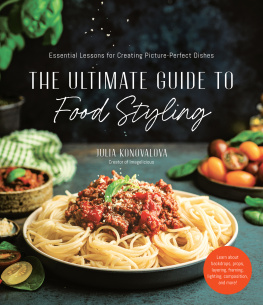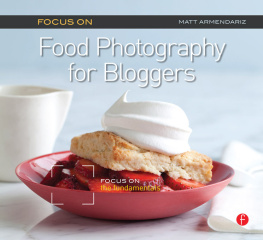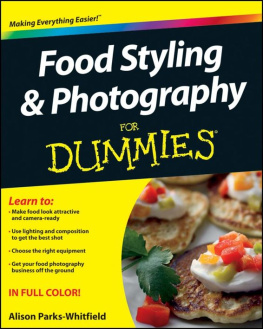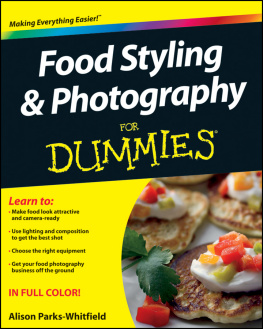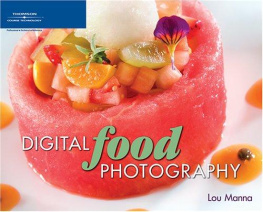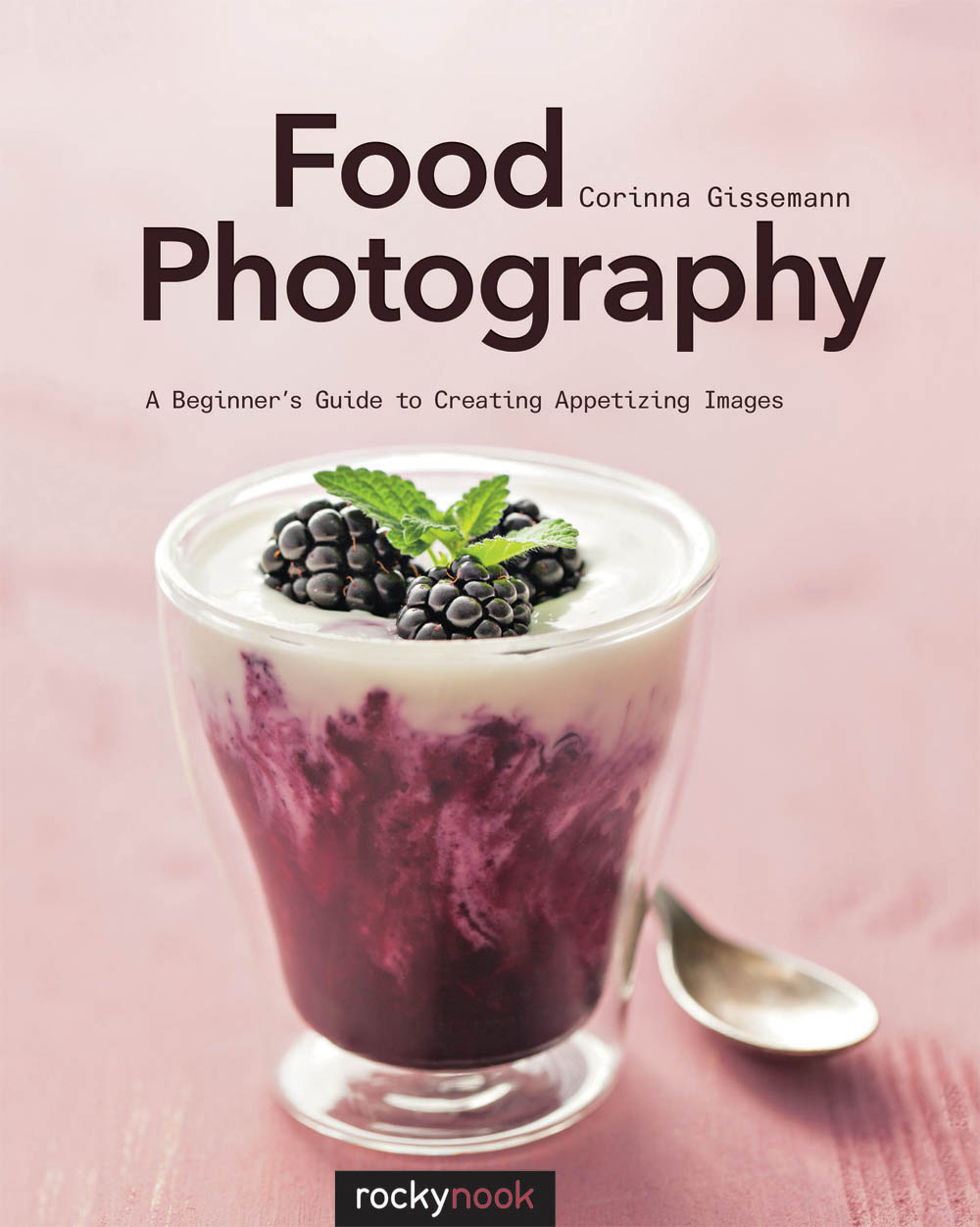
Corinna Gissemann comes from Berlin. In 2011, she decided more or less overnight to become a stock photographer. She taught herself all the basics and photography has since become her preferred form of creative expression.
Food and still life have always been Corinnas favorite genres, and her work can be found at various international agencies, in a broad range of publications, and on many peoples walls.
To find out more, visit corinnagissemann.de or send Corinna an email at
Corinna Gissemann
Food Photography
A Beginners Guide to Creating Appetizing Images

Food Photography
Corinna Gissemann
http://corinnagissemann.de/
Editor: Jocelyn Howell
Project manager: Lisa Brazieal
Marketing: Jessica Tiernan
Translation by: Jeremy Cloot
Layout and type: Cora Banek, www.corabanek.de
Cover design: Helmut Kraus, www.exclam.de
ISBN: 978-1-68198-101-7
1st Edition (1st printing, July 2016)
2016 Corinna Gissemann
All images Corinna Gissemann unless otherwise noted
Rocky Nook Inc.
1010 B Street, Suite 350
San Rafael, CA 94901
USA
www.rockynook.com
Distributed in the U.S. by Ingram Publisher Services
Distributed in the UK and Europe by Publishers Group UK
Library of Congress Control Number: 2016930695
All rights reserved. No part of the material protected by this copyright notice may be reproduced or utilized in any form, electronic or mechanical, including photocopying, recording, or by any information storage and retrieval system, without written permission of the publisher.
Many of the designations in this book used by manufacturers and sellers to distinguish their products are claimed as trademarks of their respective companies. Where those designations appear in this book, and Rocky Nook was aware of a trademark claim, the designations have been printed in caps or initial caps. All product names and services identified throughout this book are used in editorial fashion only and for the benefit of such companies with no intention of infringement of the trademark. They are not intended to convey endorsement or other affiliation with this book.
While reasonable care has been exercised in the preparation of this book, the publisher and author assume no responsibility for errors or omissions, or for damages resulting from the use of the information contained herein or from the use of the discs or programs that may accompany it.
This book is printed on acid-free paper.
Printed in China.
This book is dedicated to my parents, who have always supported me in everything I do; to my wonderful husband, who never loses his patience, whatever I may be up to; and, of course, to my little bundle of sunshine, my daughter Emma, who is just as crazy as I am.
Table of Contents

ISO 100 1/6 second f/5.6 100mm
CHAPTER 1
What Gear Do You Need?
So what do you need to shoot great food photos? The most important thing is the food itself. If you dont have some kind of edible subject I guess you wouldnt be reading this book in the first place. Alongside the subject itself, the gear you use is an important factor, so well cover this topic in detail.
Consider this old joke: A cook says to a photographer, Your photos are greatyou must have a really good camera! The photographer replies, I love your food tooyou must have great pots and pans.
Just as a good cook can create a wonderful meal regardless of the types of pots, pans, and knives she uses, you can capture great images of food using a cell phone, a full-frame DSLR, or whatever camera you like. Once you have made your initial investment in a camera and a lens or two, any additional gear shouldnt cost very much at all.
The gear you need depends on how you use the results. Using a cell phone to take pictures you plan to post on social networking sites requires a different approach than shooting high-quality images for your food blog or commercial sale. This book assumes that you are aiming higher than just using your phone.
When I am shooting food, I use a full-frame DSLR with 50mm, 100mm, and 70200mm lenses, an accessory flash, a tripod, and various light shapers (more on these later). However, you can follow all the tips in the text using a compact camera, as long as your camera allows you to make some adjustments. Check your cameras manual to see whats possible and whats not. If you want to try food photography using your phone, check out the list of apps that simulate features found in real cameras at the end of this chapter.
So what exactly makes a food photo great? If you look at the work of established food photographers, you will notice that most of them contain some or all of the following elements:
- Deliberate use of sharpness and blur
- Lighting effects (the direction, style, and color of light, as well as contrast between light and dark)
- Color
- Textures (the style of the surfaces involved)
- Props such as plates, flatware, backgrounds, etc.
- A specific arrangement of the subject within the frame
- Careful use of perspective, angle of view, and camera viewpoint (usually close to the subject)
Only the first two points have anything to do with the gear you use, and you will learn all about the others in the course of this book. The following sections will help you decide what you need.

An interchangeable-lens reflex camera
Which Camera?
There is no right camera for food photography, and you will probably want to use your camera to photograph other things too. The basic types of camera available are compact, reflex, and mirrorless system cameras. Without going into the number of megapixels a camera hasall of todays cameras have enough, unless you want to print images for house-sized postersthe differences between the various types are as follows: Compact and bridge cameras have built-in lenses, whereas the lenses in reflex and mirrorless system cameras can be swapped, allowing you to select the ideal lens for the job at hand. This is a great advantage in food photography, but it also tends to be more expensive. If you do decide to purchase a compact camera, make sure it has a fast lens with a maximum aperture of at least f/2 (Ill explain what this means in the next section) and a zoom range that covers everything from medium wide-angle to medium telephoto. A short minimum focus distance is really useful ). Food photography with a compact camera is only fun if all of these criteria are fulfilled. If you use a reflex or mirrorless system camera, these will all be standard features. Ask your photographer friends which camera they recommend. The next important matter to discuss is what to look out for when choosing a lens.

A compact camera with a built-in lens


